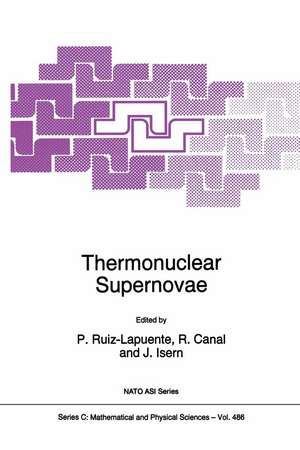Thermonuclear Supernovae: Nato Science Series C:, cartea 486
Editat de P. Ruiz-Lapuente, R. Canal, J. Isernen Limba Engleză Paperback – 5 oct 2013
| Toate formatele și edițiile | Preț | Express |
|---|---|---|
| Paperback (1) | 1596.91 lei 38-44 zile | |
| SPRINGER NETHERLANDS – 5 oct 2013 | 1596.91 lei 38-44 zile | |
| Hardback (1) | 1851.62 lei 6-8 săpt. | |
| SPRINGER NETHERLANDS – 30 noi 1996 | 1851.62 lei 6-8 săpt. |
Din seria Nato Science Series C:
- 24%
 Preț: 797.69 lei
Preț: 797.69 lei - 18%
 Preț: 957.62 lei
Preț: 957.62 lei - 18%
 Preț: 957.13 lei
Preț: 957.13 lei - 18%
 Preț: 1227.52 lei
Preț: 1227.52 lei -
 Preț: 396.40 lei
Preț: 396.40 lei -
 Preț: 403.75 lei
Preț: 403.75 lei - 18%
 Preț: 1239.37 lei
Preț: 1239.37 lei - 18%
 Preț: 1236.51 lei
Preț: 1236.51 lei - 18%
 Preț: 1231.78 lei
Preț: 1231.78 lei - 18%
 Preț: 1229.10 lei
Preț: 1229.10 lei - 18%
 Preț: 1835.21 lei
Preț: 1835.21 lei - 24%
 Preț: 1076.39 lei
Preț: 1076.39 lei -
 Preț: 390.46 lei
Preț: 390.46 lei -
 Preț: 369.63 lei
Preț: 369.63 lei - 18%
 Preț: 1232.41 lei
Preț: 1232.41 lei -
 Preț: 394.51 lei
Preț: 394.51 lei - 18%
 Preț: 1226.24 lei
Preț: 1226.24 lei - 18%
 Preț: 1845.80 lei
Preț: 1845.80 lei -
 Preț: 399.88 lei
Preț: 399.88 lei -
 Preț: 384.28 lei
Preț: 384.28 lei -
 Preț: 390.88 lei
Preț: 390.88 lei -
 Preț: 381.19 lei
Preț: 381.19 lei - 18%
 Preț: 1848.64 lei
Preț: 1848.64 lei - 18%
 Preț: 951.14 lei
Preț: 951.14 lei - 18%
 Preț: 1230.35 lei
Preț: 1230.35 lei - 18%
 Preț: 1236.51 lei
Preț: 1236.51 lei -
 Preț: 401.03 lei
Preț: 401.03 lei -
 Preț: 406.25 lei
Preț: 406.25 lei - 18%
 Preț: 1230.84 lei
Preț: 1230.84 lei -
 Preț: 418.34 lei
Preț: 418.34 lei - 18%
 Preț: 1223.74 lei
Preț: 1223.74 lei
Preț: 1596.91 lei
Preț vechi: 2101.20 lei
-24% Nou
Puncte Express: 2395
Preț estimativ în valută:
305.57€ • 332.96$ • 257.49£
305.57€ • 332.96$ • 257.49£
Carte tipărită la comandă
Livrare economică 19-25 aprilie
Preluare comenzi: 021 569.72.76
Specificații
ISBN-13: 9789401064088
ISBN-10: 9401064083
Pagini: 940
Ilustrații: XXII, 890 p.
Dimensiuni: 160 x 240 x 49 mm
Ediția:Softcover reprint of the original 1st ed. 1997
Editura: SPRINGER NETHERLANDS
Colecția Springer
Seria Nato Science Series C:
Locul publicării:Dordrecht, Netherlands
ISBN-10: 9401064083
Pagini: 940
Ilustrații: XXII, 890 p.
Dimensiuni: 160 x 240 x 49 mm
Ediția:Softcover reprint of the original 1st ed. 1997
Editura: SPRINGER NETHERLANDS
Colecția Springer
Seria Nato Science Series C:
Locul publicării:Dordrecht, Netherlands
Public țintă
ResearchCuprins
Type la supernovae: observational overview.- Supernova theory: an overview.- Infrared and optical spectroscopy of Type la supernovae.- Modeling the light curves of Type la supernovae.- The rate of supernovae: biases and uncertainties.- Statistical studies of supernovae.- Correlation of SN positions with spiral arms.- Scenarios for Type la supernovae.- The double degenerate population in the solar neighborhood.- Luminous supersoft X—ray sources as Type la progenitors.- Pre-explosion evolution of sub-Chandrasekhar Type la supernovae.- A phenomenological approach to the formation of massive CO white dwarfs.- The merging of white dwarfs.- SNe Ia: on the binary progenitors and expected statistics.- The elusive close binary white dwarfs.- Radio emission from Type la supernovae: a test of symbiotic star progenitor systems. The case of SN 1986G.- An observational limit on circumstellar Ha from Supernova SN 1994D.- The paths to white dwarf explosion/collapse.- Low mass SN la and the late light curve.- The final evolution of 8-10 MG stars.- Type la supernovae: flame physics and models.- Turbulence and thermonuclear burning.- Type la supernovae: nucleosynthesis and constraints on progenitors.- Flame instabilities and models of white dwarf burning.- SPH simulations of thermonuclear supernovae.- Thermonuclear supernova models.- Helium and carbon detonations in sub—Chandrasekhar white dwarfs.- Microscopic and macroscopic modeling of thermonuclear burning fronts.- Three—dimensional simulations of core ignition in sub—Chandrasekhar mass models.- Three—dimensional combustion in Type la supernovae.- Nucleosynthesis in SNe Ia and their impact on galactic evolution.- Gamma-rays and X—rays from Type la supernovae.- INTEGRAL and the Type la supernovae.- ASCA observation ofsupernova remnants.- Radiation transport in Type la supernovae.- On the correct treatment of expansion opacity in supernova light curve calculations.- Time dependence and the opacity of Type la supernovae.- NLTE modeling of SNe la near maximum light.- Models of the early—time spectra of SNe la using a Monte Carlo code.- Explosion models, light curves, spectra and H0.- The late—time emission of thermonuclear supernovae.- Analysis of the Type Ia supernova SN 1994D.- The late—time spectrum of SN 1991bg.- Type la supernovae as extragalactic distance indicators.- Maximum luminosities of Type la supernovae from Cepheid distances and the value of H0.- Scheduled discovery of 7+ high—redshift SNe: first cosmology results and bounds on q0.- The high—z SN search.- Observation of cosmological time dilation using Type Ia supernovae as clocks.- The Type la SNe rate at z ~0.4.- Type I supernova subclasses.- Type Ib and le supernovae: models and spectra.- Type Ib—Ic—IIb—IIL supernovae: common envelope evolution, instabilities, and circumstellar interaction.- New perspectives on Type le supernovae.- Concluding remarks —or— what I did on my coffee break.














